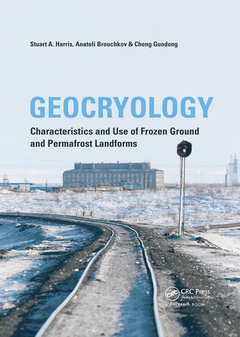Geocryology Characteristics and Use of Frozen Ground and Permafrost Landforms
Auteurs : Harris Stuart A., Brouchkov Anatoli, Guodong Cheng

This book provides a general survey of Geocryology, which is the study of frozen ground called permafrost. Frozen ground is the product of cold climates as well as a variety of environmental factors. Its major characteristic is the accumulation of large quantities of ice which may exceed 90% by volume. Soil water changing to ice results in ground heaving, while thawing of this ice produces ground subsidence often accompanied by soil flowage. Permafrost is very susceptible to changes in weather and climate as well as to changes in the microenvironment. Cold weather produces contraction of the ground, resulting in cracking of the soil as well as breakup of concrete, rock, etc. Thus permafrost regions have unique landforms and processes not found in warmer lands.
The book is divided into three parts. Part 1 provides an introduction to the characteristics of permafrost. Four chapters deal with its definition and characteristics, the unique processes operating there, the factors affecting it, and its general distribution. Part 2 consists of seven chapters describing the characteristic landforms unique to these areas and the processes involved in their formation. Part 3 discusses the special problems encountered by engineers in construction projects including settlements, roads and railways, the oil and gas industry, mining, and the agricultural and forest industries.
The three authors represent three countries and three language groups, and together have over 120 years of experience of working in permafrost areas throughout the world. The book contains over 300 illustrations and photographs, and includes an extensive bibliography in order to introduce the interested reader to the large current literature.
Finalist of the 2019 PROSE Awards.
Date de parution : 07-2020
17.4x24.6 cm
Date de parution : 09-2017
17.4x24.6 cm
Thèmes de Geocryology :
Mots-clés :
Qinghai Tibet Plateau; periglacial; Permafrost Table; tundra; Continuous Permafrost; permafrost; Rock Glaciers; thermokarst; Annual Air Temperature; frozen soils; Moisture Content; arctic; Active Layer; Anatoli Brouchkov; Frost Heave; Cheng Guodong; Thawing Indices; Permafrost Areas; Ice Wedge Casts; Seasonal Frost; Warm Permafrost; Annual Ground Temperature; Ice Content; Ice Lenses; Gas Hydrates; Ice Rich Permafrost; Deep Active Layer; Permafrost Soils; Underlying Permafrost; Plateau Mountain; Block Streams; Ice Segregation



